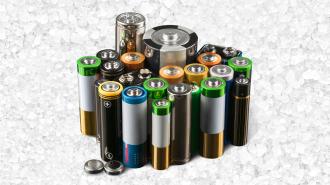A new type of low-cost battery could help solve the renewable energy storage problem, giving us a better way to bank solar and wind energy for when the sun isn’t shining and the wind isn’t blowing.
The challenge: A whopping 30% of global CO2 emissions are produced by coal-fired power plants, and decarbonizing the electric grid is a vital part of combating climate change.
We can speed the transition to a clean electric grid by storing excess energy in batteries, but lithium-ion ones are expensive.
Solar and wind power have become dramatically cheaper over the past couple of decades. However, these sources still depend on environmental conditions — without wind, turbines can’t spin, and if the sun isn’t shining, solar panels (usually) can’t harvest energy.
That makes these sources less consistent than fossil fuels, which can be dispatched on demand, and so even while solar and wind continue to grow, utilities continue to rely on gas to fill gaps and keep the electric grid stable.
Energy storage: We can speed the transition to renewable power by storing excess energy in batteries and then deploying it when the sun and wind aren’t cooperating with demand. Many newer renewable energy plants are being paired with big banks of lithium-ion batteries, but lithium is expensive, and mining it is bad for the environment in other ways.
“Storage solutions that are manufactured using plentiful resources like sodium … have the potential to guarantee greater energy security.”
Shenlong Zhao
Room-temperature sodium-sulfur (RT Na-S) batteries are a promising alternative for renewable energy storage. They rely on chemical reactions between a sulfur cathode and a sodium anode to store and deploy electrical energy, and they use low-cost materials, which can even be easily extracted from saltwater.
“Storage solutions that are manufactured using plentiful resources like sodium … have the potential to guarantee greater energy security more broadly and allow more countries to join the shift towards decarbonisation,” said Shenlong Zhao, an energy storage researcher at the University of Sydney.
What’s new? Existing RT Na-S batteries have had limited storage capacity and a short life cycle, which has held back their commercialization, but there’s now a new kind of RT Na-S battery, developed by Zhao’s team.
According to their paper, the device has four times the storage capacity of a lithium-ion battery and an ultra-long life — after 1,000 cycles, it still retained about half of its capacity, which the researchers claim is “unprecedented.”
“This is a significant breakthrough for renewable energy development.”
Shenlong Zhao
This leap was possible thanks to the incorporation of carbon-based electrodes and the use of a process called “pyrolysis” to improve the reactivity of the sulfur and the reactions between the sulfur and sodium.
“This is a significant breakthrough for renewable energy development which, although reduces costs in the long term, has had several financial barriers to entry,” said Zhao.
The big picture: So far, the Sydney researchers have only created and tested lab-scale versions of their RT Na-S battery. They now plan to focus on scaling up and commercializing the tech, which will likely take several years.
There are many other alternatives to lithium-ion batteries that can be used for renewable energy storage today, though, including long-living flow batteries, massive water batteries, and batteries that store electricity as heat in bricks, sand, and other solid materials.
The sooner we scale up our use of renewables and deploy more of these batteries — and innovative newcomers, like the University of Sydney’s creation — the better our chances of avoiding the worst possible effects of climate change.
We’d love to hear from you! If you have a comment about this article or if you have a tip for a future Freethink story, please email us at [email protected].






